Letters from Arthur Seaforth Blackburn to his family, 1941 - Part 5
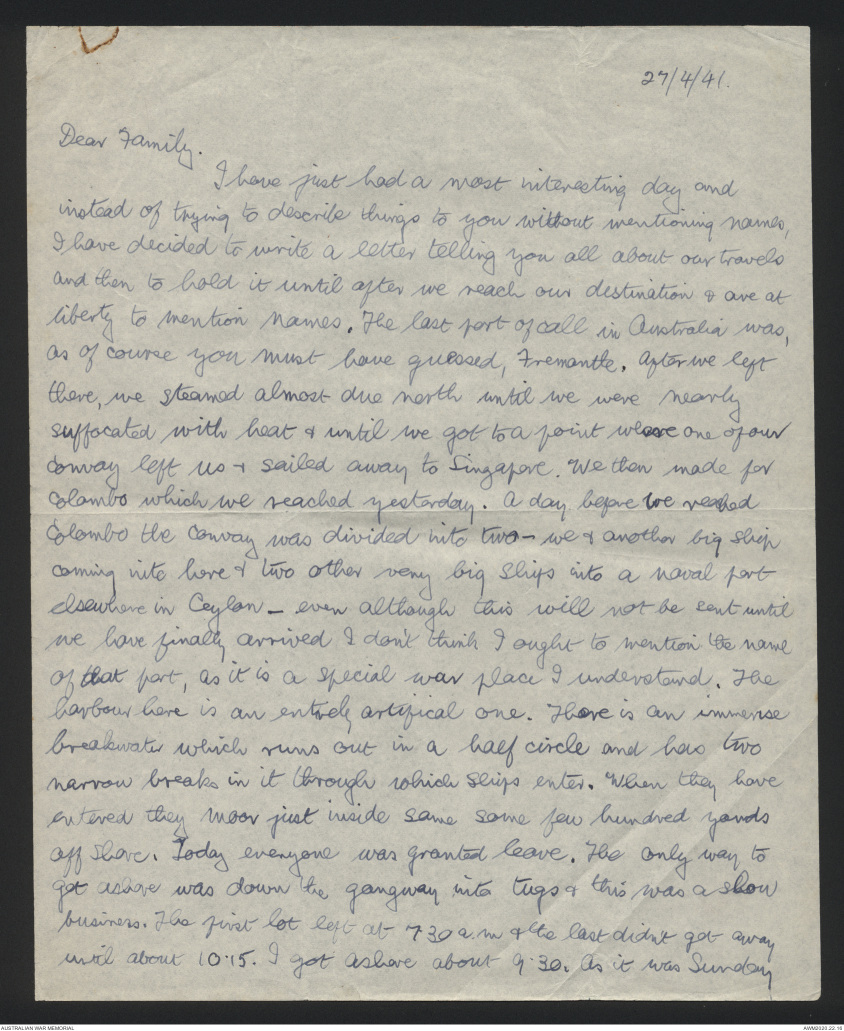
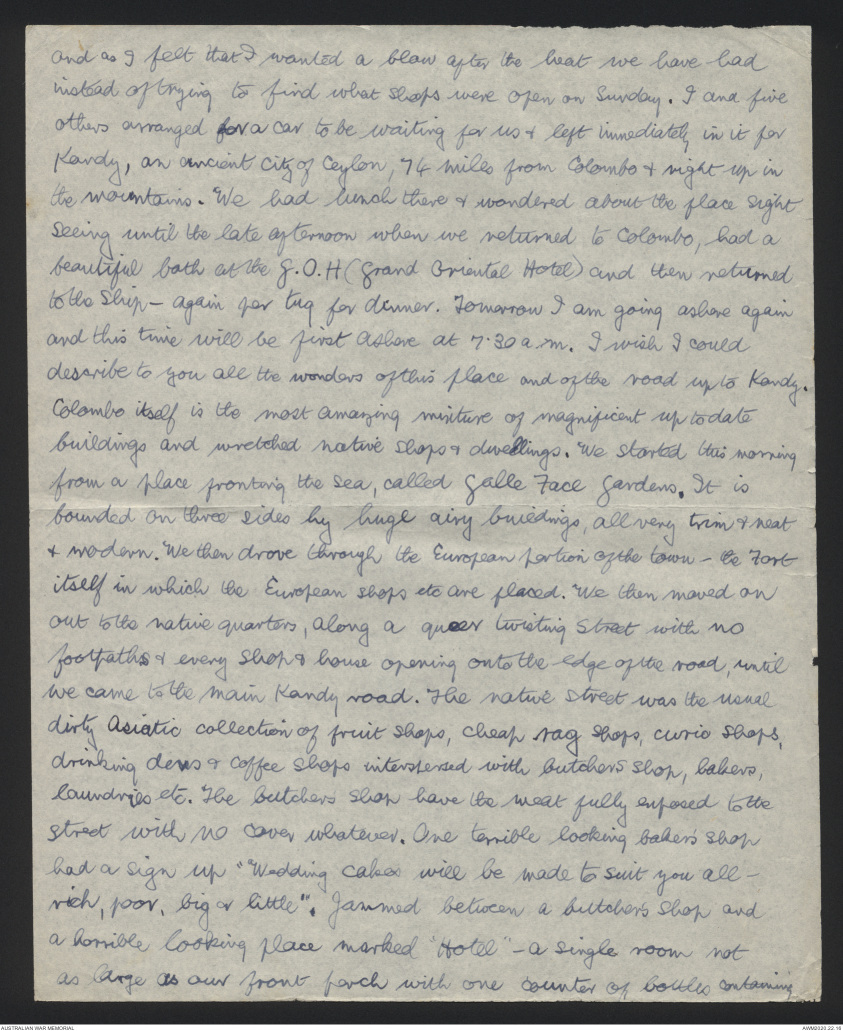
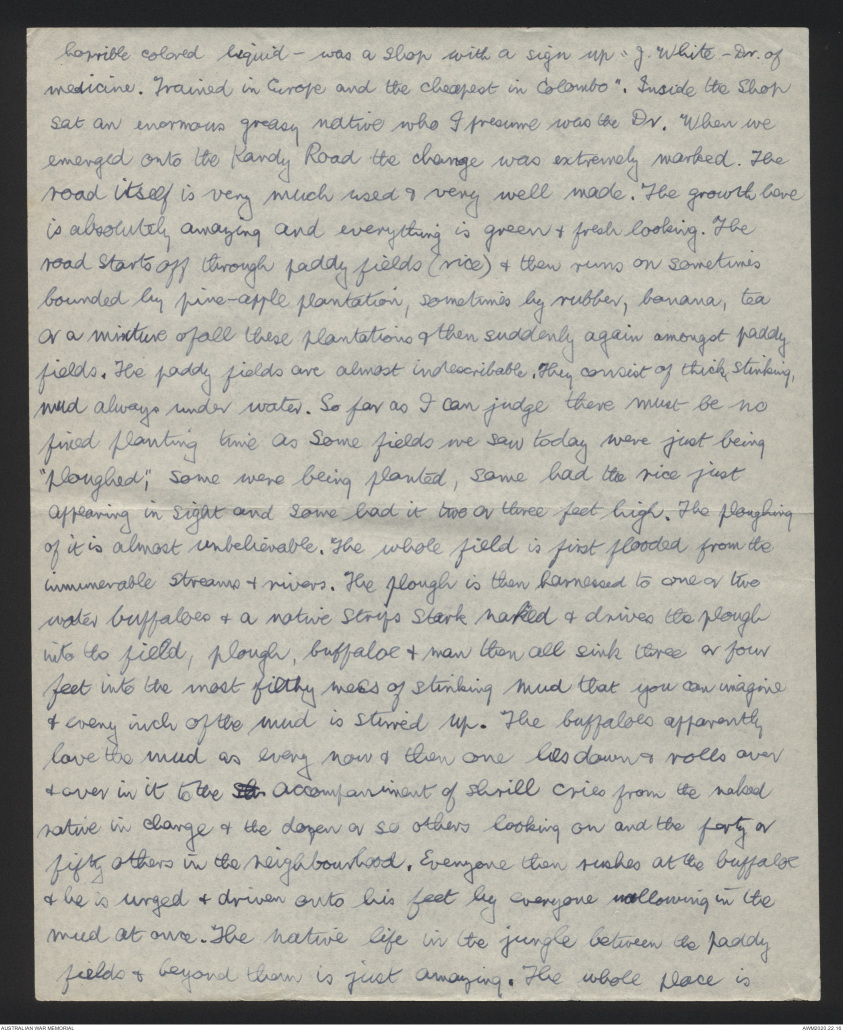
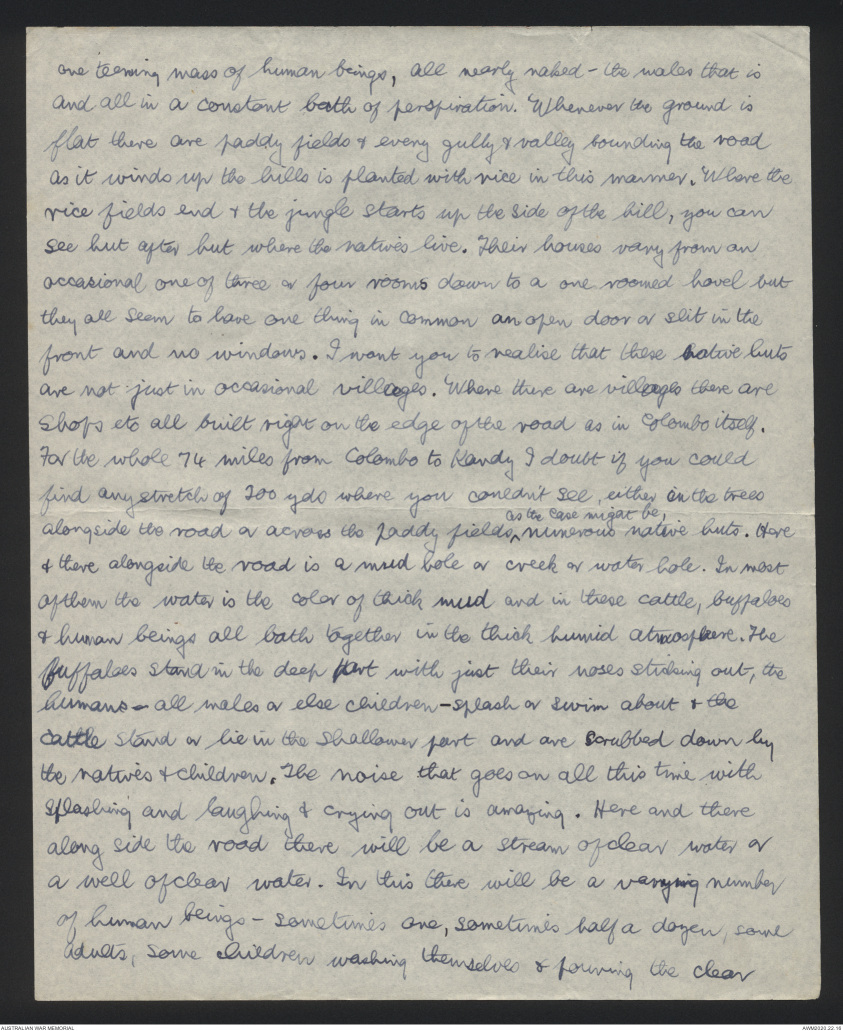
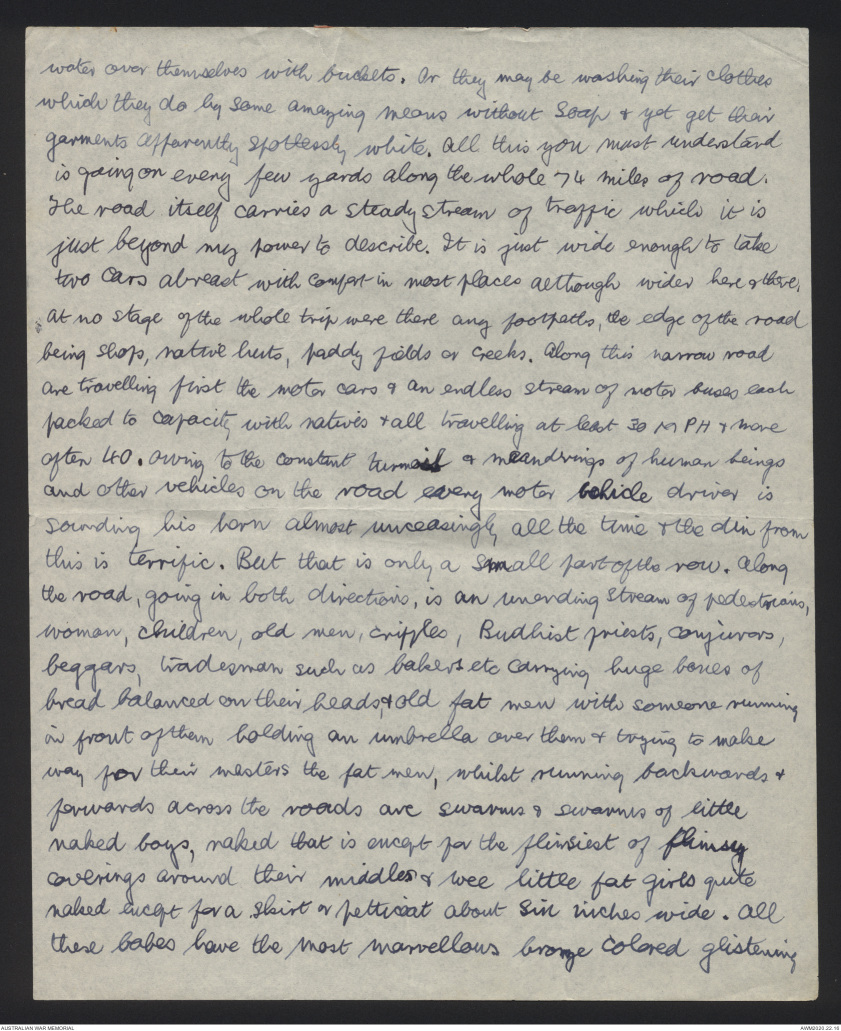
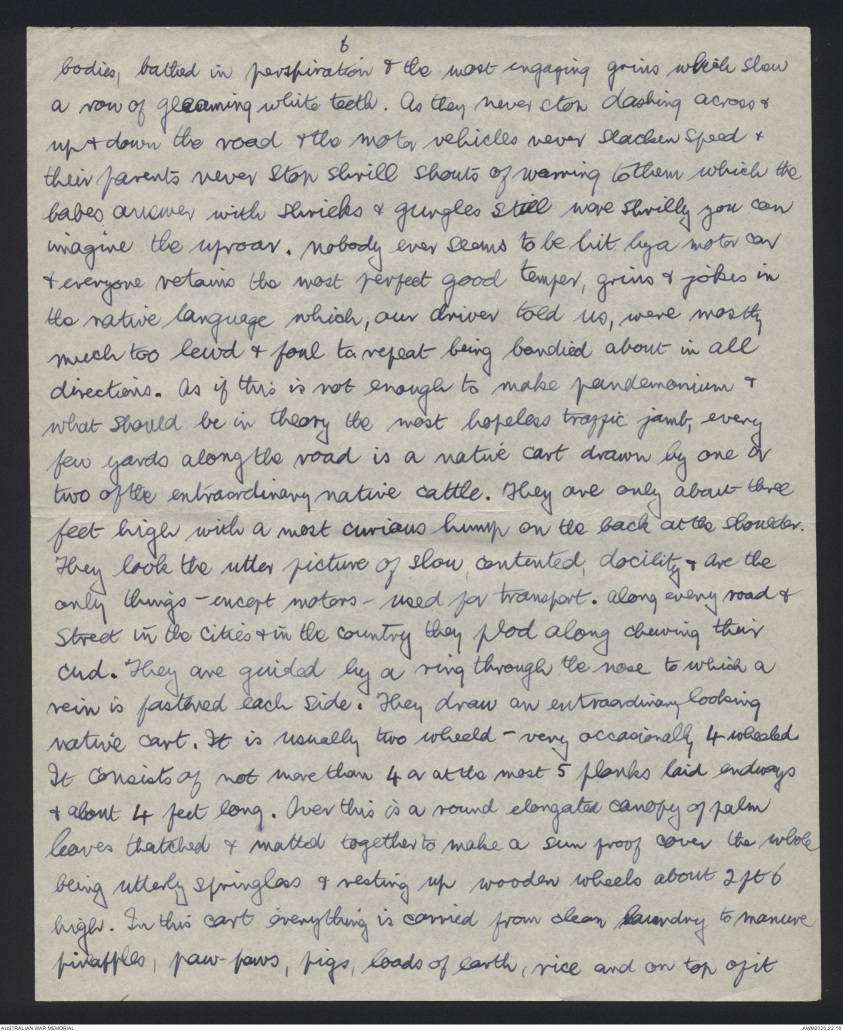
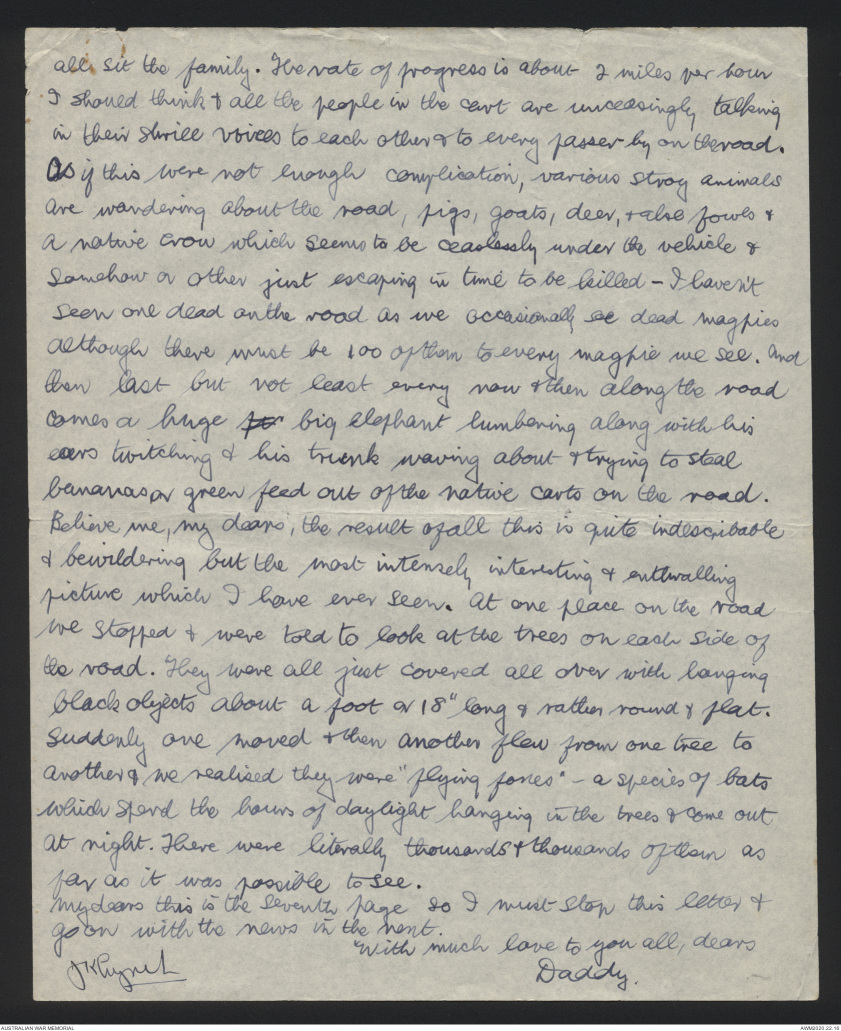
27/4/41
Dear Family,
I have just had a most interesting day and
instead of trying to describe things to you without mentioning names,
I have decided to write a letter telling you all about our travels
and then to hold it until after we reach our destination & are at
liberty to mention names. The last port of call in Australia, was
as of course you must have guessed, Fremantle. After we left
there, we steamed almost due north until we were nearly
suffocated with the heat & until we got to a point where one of our
convoy left us & sailed away to Singapore. We then made for
Colombo which we reached yesterday. A day before we reached
Colombo the convoy was divided into two - we and another big ship
coming into here & two other very big ships into a naval port
elsewhere in Ceylon - even although this will not be sent until
we have finally arrived I don't think I ought to mention the name
of that port, as it is a special war place I understand. The
harbour here is an entirely artifical one. There is an immense
breakwater which runs out in a half circle and has two
narrow breaks in it through which ships enter. When they have
entered they moor just inside same some few hundred yards
off shore. Today everyone was granted leave. The only way to
get ashore was down the gangway into tugs & this was a slow
business. The first lot left at 7.30 a.m & the last didn't get away
until about 10.15. I got ashore about 9.30. As it was Sunday
and as I felt that I wanted a blow after the heat we have had
instead of trying to find what shops were open on Sunday. I and five
others arranged for a car to be waiting for us & left immediately in it for
Kandy, an ancient city of Ceylon, 74 miles from Colombo & right up in
the mountains. We had lunch there & wandered about the place sight
seeing until the late afternoon when we returned to Colombo, had a
beautiful bath at the G.O.H (Grand Oriental Hotel) and then returned
to the ship - again per tug for dinner. Tomorrow I am going ashore again
and this time will be the first at 7.30am. I wish I could
describe to you all the wonders of this place and of the road up to Kandy.
Colombo itself is the most amazing mixture of magnificent up to date
buildings and wretched native shops & dwellings. We started this morning
from a place fronting the sea, called Galle Face Gardens. It is
bounded on three sides by huge airy buildings, all very trim & neat
& modern. We then drove through the European portion of the town - the Fort
itself in which the European shops etc are placed. We then moved on
out to the native quarters, along a queer twisting street with no
footpaths & every shop & house opening onto the edge of the road, until
we came to the main Kandy road. The native street was the usual
dirty Asiatic collection of fruit shops, cheap rag shops, curio shops,
drinking dens & coffee shops interspersed with butchers shop, bakers,
laundries etc. The butcher's shop have the meat fully exposed to the
street with no cover whatever. One terrible looking baker's shop
had a sign up " Wedding Cakes will be made to suit you all -
rich, poor, big or little". Jammed between a butcher's shop and
a horrible looking place marked "Hotel" - a single room not
as large as our front porch with one counter of bottles containing
horrible colored liquid-was a shop with a sign up “ J White-Dr. of
medicine. Trained in Europe and the cheapest in Colombo”. Inside the shop
sat an enormous greasy native who I presume was the Dr. When we
emerged onto the Kandy Road the change was extremely marked. The
road itself is very much used & very well made. The growth here
is absolutely amazing and everything is green & fresh looking. The
road starts off through paddy fields (rice) & then runs on sometimes
bounded by pine-apple plantation, sometimes by rubber, banana, tea
or a mixture of all these plantation & then suddenly again amongst paddy
fields. The paddy are almost indescribable. They consist of thick stinking,
mud always under water. So far as I can judge there must be no
fixed planting time as some fields we saw today were just being
“ploughed“, some were being planted, some had the rice just
appearing in sight and so we had it two or three feet high. The ploughing
of it is almost unbelievable. The whole field is first flooded from the
innumerable streams & rivers. The plough is then harnessed to one or two
water buffaloes & a native strips stark naked & drives the plough
into the field, plough, buffaloe & man then all sink three or four
feet into the most filthy mess of stinking mud that you can imagine
& every inch of the mud is stirred up. The buffaloes apparently
love the mud as very now & then one lies down & rolls over
& over in it to the sh accompaniment of shrill cries from the naked
native in charge & the dozen or so others looking on and the forty or
fifty others in this neighbourhood. Everyone then rushes at the buffaloe
& he is urged & driven onto his feet by everyone wallowing in the
mud at once. The native life in the jungle between the paddy
fields & beyond them is just amazing. The whole place is
one teeming mass of human beings, all nearly naked - the males that is
and all in a constant bath of perspiration. Whenever the ground is
flat there are paddy fields & every gully & valley bounding the road
as it winds up the hills is planted with rice in this manner. Where the
rice fields end & the jungle starts up the side of the hill, you can
see hut after hut where the natives live. Their houses vary from an
occasional one of three or four rooms down to a one roomed hovel but
they all seem to have one thing in common an open door or slit in the
front and no windows. I want you to realise that these native huts
are not just in occasional villages. Where there are villages there are
shops etc. all built right on the edge of the road as in Colombo itself.
For the whole 74 miles from Colombo to Kandy I doubt if you could
find any stretch of 200 yds where you couldn't see, either in the trees
alongside the road or across the paddy fields as the case might be, numerous native huts. Here
& there alongside the road is a mud hole or creek or water hole. In most
of them the water is the color of thick mud and in these cattle, buffaloes
& human beings all bath together in the thick humid atmosphere. The
buffaloes stand in the deep part with just their noses just sticking out, the
humans - all males or else children - splash or swim about & the
cattle stand or lie in the shallower part and are scrubbed down by
the natives & children. The noise that goes on all this time with
splashing and laughing & crying out is amazing. Here and there
along side the road there will be a stream of clear water or
a well of clear water. In this there will be varying number
of human beings - sometimes one , sometimes half a dozen, some
adults, some children washing themselves & pouring the clear
water over themselves with buckets. Or they may be washing their clothes
which they do by some amazing means without soap & yet get their
garments apparently spotlessly white. All this you must understand
is going on every few yards along the whole 74 mile of road.
The road itself carries a steady stream of traffic which it is
just beyond my power to describe. It is just wide enough to take
two cars abreast with comfort in most places, although wider here & there,
at no stage of the whole trip were there any footpaths, the edge of the road
being shops, native huts, paddy fields or creeks. Along this narrow road
are travelling first the motor cars & an endless stream of motor buses each
packed to capacity with natives & all travelling 30 m.p.h & more
often 40. Owing to the constant turmoil & meanderings of human beings
and other vehicles on the road every motor vehicle driver is
sounding his horn almost unceasingly all the time & the din from
this is terrific. But that is only a small part of the row. Along
the road, going in both directions, is a unending stream of pedestrians,
women, children, old men, cripples, Budhist priests, conjurors,
beggars, tradesmen such as bakers etc carrying huge boxes of
bread balanced on their heads, & old fat men with someone running
in front of them holding an umbrella over them & trying to make
way for their masters the fat men, whilst running backwards &
forwards across the roads are swarms & swarms of little
naked boys, naked that is except for the flimsiest of flimsy
coverings around their middles & wee little fat girls quite
naked except for a shirt or petticoat about six inches wide. All
these babes have the most marvellous brown colored glistening
6
bodies, bathed in perspiration & to the most engaging grins which show
a row of gleaming white teeth. As they never stop dashing across &
up & down the road & the motor vehicles never slacken speed &
their parents never stop shrill shouts of warnings to them which the
babes answer with shrieks & gurgles, still more shrilly you can
imagine the uproar. Nobody ever seems to be hit by a motor car
& everyone retains the most perfect good temper, grins & jokes in
the native language which, our driver told us, were mostly
much to lewd & foul to repeat being bandied about in all
directions. As if this is not enough to make pandemonium &
what should be in theory the most hopeless traffic jamb, every
few yards along the road is a native cart drawn by one or
two of the extraordinary native cattle. They are only about three
feet high with a most curious hump on the back at the shoulder.
They look the utter picture of slow, contented ,docility & are the
only things - except motors - used for transport. Along every road &
street in the cities & in the country they plod along chewing their
cud. They are guided by a ring through the nose to which a
rein is fastened each side. They draw an extraordinary looking
native cart. It is usually two wheeled - very occasionally 4 wheeled.
It consists of not more then 4 or at the most 5 planks laid endways
& about 4 feet long. Over this is a round elongated canopy of palm
leaves thatched & matted together to make a sun proof cover the whole
being utterly springless & resting up wooden wheels about 2 ft 6
high. In this cart everything is carried from clean laundry to manure,
pineapples, paw-paws, pigs, loads of earth, rice and on top of it
all sit the family. The rate of progress is about 2 miles per hour
I should think & all the people in the cart are unceasingly talking
in their shrill voices to each other & to every passer by on the road.
As if this were not enough complication, various stray animals
are wandering about the road, pigs, goats, deer & also fowls &
a native crow which seems to be ceaselessly under the vehicle &
somehow or other just escaping in time to be killed - I haven’t
seen one dead on the roads as we occasionally see dead magpies
although there must be 100 of them to every magpie we see. And
then last but not least every now & then along the road
comes a huge fi big elephant lumbering along with his
ears twitching & his trunk waving about & trying to steal
bananas or green feed out of the natives cart on the road.
Believe me, my dears, the results of all this is quite indescribable
& bewildering but the most intensely interesting & enthralling
picture which I have ever seen. At one place on the road
we stopped & were told to look at the trees on each side of
the road. They were all just covered all over with hanging
black objects about a foot or 18” long & rather round & flat.
Suddenly one moved & then another flew from one tree to
another & we realised they were “flying foxes” - a species of bats
which spend the hours of daylight hanging in the trees & come out
at night. There were literally thousands & thousands of them as
far as it was possible to see.
My dears this is the seventh page so I must stop this letter
& go on with the news in the next.
With much love to you all, dears
Daddy.
JK Cupril
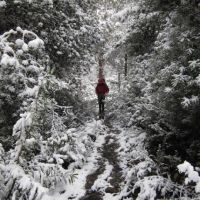 Chris Lamb
Chris LambThis transcription item is now locked to you for editing. To release the lock either Save your changes or Cancel.
This lock will be automatically released after 60 minutes of inactivity.